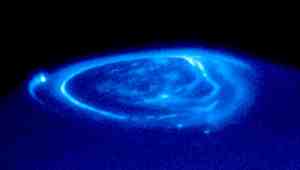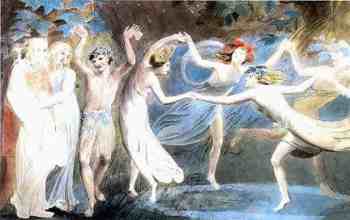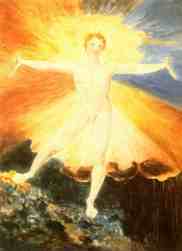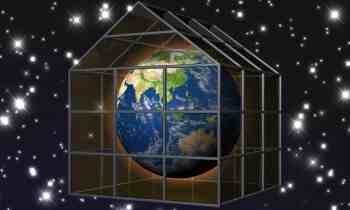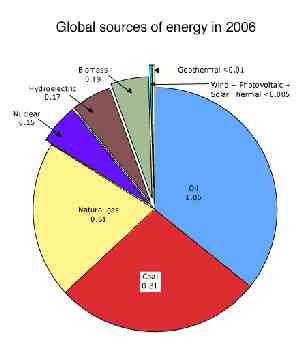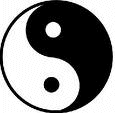|
Enjoying
the bliss, which is energy. |
||||||||||||||||
|
The
|
William Blake
wrote “Energy is eternal delight” and it said he died at 70 singing
songs of joy. He was dismissed as eccentric, if not an insane.
What vision of energy did this man have who writes; “To
see the world in a grain of sand, and to see heaven in a wild flower,
hold infinity in the palm of your hands, and eternity in an hour”? In
this he foresaw the messages of quantum physics. What vision of energy
did this man have that he writes of “the dark Satanic mills” in
referring to the early Industrial Revolution. In this he foresaw the
World Wars, our current despoiled planet and our society now at the
brink of self-destruction. Many
“environmentalists” now experience confusion and hopelessness in the
aftermath of the hoopla and travel-frenzy that was Copenhagen with all
its destruction of resources and pollution. They feel their messages of
the need for stewardship are unheard. Could it be that their real
messages are not what they think they are and they are communicating
with perfect clarity? Could it be the dissonance, denial, confusion and
lack of hope they see in their audience is a reflection of their own?
By contrast it is said Blake never travelled more than thirty
miles from his birthplace and yet over two centuries later his messages
continue to resonate with hope in millions of people in the furthest
lands on the planet. (I, for instance, live in New Zealand).
I
know little of William Blake and his work. I do know art enables us to
transcend our ego and he was a skilled artist. I do know that for many
years I tagged my signature with the quote “Energy
is eternal delight” –William Blake.
This was my response to those who preach that energy threatens and fails
us. All this inspires
the question, “What is energy?” The answer seems to be that though
we are each intimate with energy no human being truly knows what it is
and perhaps no human being can ever know its full, true nature. We do
know that many great sages over the millennia have enjoyed a vision of
the nature of energy that fills them with awe and wonder such that they
cannot find words to express it. We also have great guides to the nature
of energy in the Conservation, Uncertainty and
Sustainability Principles of Energy. However our educators rarely unpack their
fuller wisdom. The
Conservation Principle of Energy has several great messages including
the notions that energy is so bounteous that it can be considered a
constant, that energy continually transforms and that we are part of a
universal flux. This principle is as near as we have to a natural law,
for no other symbolisation of existence has been subject to such intense
scrutiny. Despite our best endeavours no human being has ever invented a
perpetual motion machine, invented an elixir of youth or evaded
mortality. We live a conundrum, an intricate and difficult problem.
While our egos are threatened by concepts of mortality and desperately
attempt to deny the reality of constant transformation our senses
constantly remind us that all is change. Similarly
the Uncertainty Principle of Energy seems continually proven, as shown
by the ever-growing array of new electronic technologies spawned of its
insights. Again its messages are inconvenient for our ego, for egos
dissolve in the paradox and interconnection of all. And the Uncertainty
Principle presents us with a conundrum too - it reminds us that the
state of human beings is characterised by uncertainty even as it also
reminds us that we are stewards of our actions, whether we like it or
not. Together these
Principles suggest that reality is continual transformation that we are
each part of. In this reality we each have a role as a steward of our
actions amidst the universal action. Indeed it is possible that in the
ultimate the notions of change and stewardship are so intimately
connected that they are nearly indistinguishable. And here we get
to the crux of our situation: self-consciousness contains equal
potential for self-respect and self-deceit. We have the capacity to
develop very sophisticated psychological mechanisms to live in
acceptance and in denial of change/stewardship. Deciding how to use this
potential is compounded by the fact that our consciousness is but a
trace element of our being. Neurophysics suggests that while in any
moment we are each conscious of maybe a couple of thousand interactions
with the universe(s) our primal being is sentient of perhaps 50 billion
interactions. And while our cells contain wisdom that has sustained
their structure a billion years through all manner of change our egos
have a great capacity to deny this wisdom. This phenomenon of denial is easily illustrated. Give yourself the experience of five minutes uninterrupted sentience of existence. Unless you are skilled in transcending the ego then you will find this the hardest task you have ever attempted. The mind with great ingenuity and persistence constantly interrupts the awareness so that within seconds most of us are thinking some thought rather than simply experiencing the sensations of all. Such is the power for self-deceit residing in us all. This capacity is so powerful we cannot think or wish it gone. Indeed such endeavour only fuels the ego’s capacity for self-deceit. However we do have the capacity to transcend it. Our greatest psychologists over millennia consistently remind us of our capacity for compassion and its power. They suggest from experience that in an enhanced state of compassion we find acceptance of the human condition and even much humour in it. In such moments the ego with its often-unhelpful demands and strictures dissolves of its own accord with ease.
Could it be that
it was such an experience that motivated William Blake to symbolise
energy is such a sublime way? Are we denying our self an amazing vision
of the nature of energy? Why
are so many of us dominated by sensations of fear and deprivation rather
than harmony and abundance? Perhaps it is
helpful to be mindful of what else we know of the nature of energy. I mentioned how
our educational institutions fail to unpack all the wisdom in the great
Principles of Energy. Indeed most of them actively deny this wisdom in
myriad ways that I will detail later. For now I will draw your attention
to two more of their unhelpful practices. It is common for
our education institutions to teach that there are two forms of energy
– potential (stored) and kinetic (movement). This is unhelpful. The
meaning of the “potential” symbol derives from the Latin
“potens” – “to be able and is anything that may be possible;
having possibility, capability, or power.” In other words it
is anything that is and anything that could be. A brief example
illustrates the limitations of the potential/kinetic dichotomy of our
educators. Imagine a mountain with a beautiful valley with permanent
pure fresh water stream, deep fertile soils, sheltered and sunny. It is
an ideal place to create an abode. Now imagine balanced in most
precarious way overhanging the valley is an immense rock. Our teachers
point to the grass moving in the wind and the flowing waters and say
these manifest kinetic energy. They point to the unmoving rock and say
it has potential energy and describe its impacts if it did crash down
the valley. What they fail to
communicate is the mind-matter relationship. They fail to understand
that information is physical. Measurable electrochemical changes occur
in our bodies as we imagine the potential of that rock. Even if we are
not directly looking at the rock our knowledge of its potential to crash down
that can be measured as kinetic energy. The unmoving rock continually
and materially alters the valley because we refrain from making our
abode in it. It is a sustained force. The potential of the rock exists
as kinetic energy, albeit in our minds. Our educators
also obscure Quantum Physics for us. For instance an electron is
actualised for a trace, trace moment like a momentary glint on a wave in
a vast ocean of potential or possibilities, We cannot observe it without
affecting how it is manifest and any change spontaneously causes a
related change somewhere else in the universe. This is explained to us,
and then we are told this is not relevant to our daily lives and the
insights are packed away in the Too Hard boxes labeled “Quantum
Theory” and “Paradox”. It seems energy
can be better understood as being the potential of the universe(s). It
is more helpful to speak of actual potential and non-actual potential.
Or if you like, realised potential and non-realised potential. The
potential that is realised and manifest in any moment to us is an
absolutely miniscule aspect of the total potential of the universe(s).
Perhaps this greater potential is the vision of energy our sages allude
to?
It is also common
for our educators to confuse us by saying there is stuff called Thermal
Energy, Kinetic Energy, Potential energy, Electrical Energy etc. Again
with this use of the “potential” symbol they deny the human
involvement in the potential. In framing energy
thus they also confuse energy with its perceived properties. It is more
helpful to, for instance, talk of exploring energy from an electrical
perspective or a thermal perspective or a gravitational perspective etc.
We can explore both actualised and non-actualised potential from any
perspective. This approach transforms our vision of energy from being
one in which it is experienced as a distant set of monolithic constructs
to one in which we become part of an ever-changing shimmering
kaleidoscope. Our existence becomes alive in an awareness of an immense
complexity of patterns, no two the same and yet all sharing something
indeterminate in common. And, as mentioned, our educators often frame energy as existing in half a dozen forms as in “Forms of Energy = Thermal, Kinetic, Potential, Electrical etc. They confuse possible perspectives of energy and obscure the fact energy is actually manifested in myriad forms. They deny the essential change. In short, when we
accept the Conservation Principle we become aware of a far greater
potential full of previously unimagined possibilities. Inherent in this
is hope and wonderment even as we are reminded of our mortality and
roles as stewards. The question arises why do we continue to deny this
greater potential, this truer reality? The answer lies in our ego with
its powerful elements of psychosis (inability to reflect reality) and
psychopathy (inability to enjoy compassion) allied with our grand
capacity for self-deceit. These confound and confuse us and enable us to
deny change/stewardship. And these capacities are compounded many fold
when they are projected into our social constructs. The modern
corporation is an almost perfect manifestation of our psychopathic
elements, having all the rights of individuals and none of the
responsibilities, being beholden only to the amoral construct called The
Market with its driving imperative of maximising short-term profit. The denial of
change/stewardship is endemic in our Anglo-American culture. I will not
detail the unsustainable lifestyles that this denial generates. Instead
I will concentrate on providing a few examples that illustrate how the
denial is manifest at the most fundamental level. Basically these
are examples of how our ego plays tricks on us. The universal continual change can be viewed from the thermal perspective or thermodynamics. All things are constantly warming as they are cooling. Any form, whether it is our body or the life on our planet, is only sustained while the rate of its warming is balanced by the rate of its cooling.
In this context Global Warming is a life enabling process,
which we welcome at a cellular level. For the reasons alluded to our ego
denies this fundamental order and it is common to hear people say we
must fight and stop Global Warming. They even deny the fundamental
thermodynamics of our universe(s) by confusing Global Warming (a state
of balance) with Global Warming-Up (a state of imbalance). Ask yourself,
“If warming is warming-up, then what is warming?” Right. Either one
or the other does not exist. And we are in the
situation where the wisdom of our cells is saying Global Warming is good
and our ego is saying it is bad. The result is we experience dissonance
and are less unable to reflect reality. Another example
from this thermal perspective is our use of the “climate change”
symbol. At one level we understand it is the natural order that we need
to live in harmony with. Another element of us denies our roles as
stewards/change and projects responsibility onto Earth’s climate. Thus
it is common to hear people say we must stop/combat/ kill climate change
as it is evil and threatens us. Our ego denies stewardship/change by
precluding the “use” symbol in our equations of our relationship
with Earth’s climate. Again this ego trick of projecting blame onto
the climate generates dissonance with the wise element in us, which says
we each need act as stewards of the climate balances that sustain us. A final example from this thermal perspective is our use of the “greenhouse” symbol to portray atmospheric processes.It is no coincidence this use of the symbol emerged with the advent of the Industrial Revolution because it is the perfect symbolisation of the Industrial Revolution spirit or religion. The “Greenhouse Earth” image of our planet contained in a greenhouse is the perfect manifestation of the dominant belief in our culture that this planet is here for us to engineer at the will of our ego.
For instance the Crystal Palace,
designed for the Great Industrial Exhibition of 1851, symbolised
(British) Man’s dominion over all creatures and lands of the Earth,
with all notions of stewardship having been stripped from the
“dominion” symbol. The “Greenhouse Earth” image is the perfect
manifestation of our arrogance and denial of stewardship.
The Industrial
Revolution is founded in monolithic linear thinking such that we reorder
our landscapes in straight-lines regardless of the disharmony with all.
Gaze upon the
countless straight-line posters illustrating Earth in a straight-line
greenhouse that grace the straight-line walls of our schools today and
feel the dissonance. The wisdom of our cells knows straight lines are
generated by our minds and do not reflect reality. Thus our children are
filled with dissonance. The thermodynamic
reality of our atmosphere is that air has a considerable capacity for
convective change. Our ego denies this by supplanting it with notions
such as greenhouses, sealed cars, stoppered bottles and other human
constructions with which we can actively suppress the convective
capacity of air. The dissonance caused is such that it also serves to
destroy the awareness of sustainable uses of air in insulation in our
dwellings and other devices. And, in brief,
our ego’s use of the “greenhouse” gas symbol reflects our denial
of all the implications of change/stewardship that are inherent in the
“trace” symbol. The advent of the Industrial Revolution coincided
with a growing awareness of what were then called ‘trace gases”
–gases so rare they were barely detectable. The “trace” symbol is
inconvenient for our ego as it involves a major acknowledgement of how
tiny quantities with leverage can have very large impacts. Our failure
to understand this vital notion is now being manifest in the current
massive credit and population explosions based on our trace mineral oil
resource. Similarly the evocation of the “greenhouse” symbol as in
"greenhouse gas" enables us to
deny our role as stewards of the trace gases and their very large change
potential while reassuring our ego that we can engineer the atmosphere
at will. I can give many
examples of how our symbol use reveals our denial of change/stewardship
and will restrict my discussion to a few of the more profound ones.
The Conservation
Principle states very clearly that energy is. In other words, it cannot
be created or destroyed, generated, renewed, saved, conserved,
sustained, lost etc by human beings. How often do you hear yourself,
teachers and “energy experts” denying this reality and speaking of
stuff called “renewable energy” “generated energy”,
“sustainable energy” etc? We have national institutions devoted to
telling us humans can conserve, save, generate, sustain and otherwise
alter the nature of energy. This is delusional. If the
Conservation Principle holds, then the reality is that human beings can
only work to sustain balances and conserve/save/sustain resources and renewable
sources of energy. Which brings us
to another trick our ego plays on us. It is a classic example of our
capacity for self-deceit. The Conservation Principle of Energy reminds
us energy is bounteous as the universe(s) and continually transforms. It
may be manifest in myriad forms and each of those forms is transient,
existing only for trace moments. Some of these forms may be valuable
resources for us and our ego can find it very convenient to deny our
role as stewards of them. Its trick is to symbolise the resource as
energy and thus we feel able to value and use it as though it is as
bounteous as energy.
The great
contemporary example of this trick is our response to our discovery of
fossilised carbon as a fuel resource, especially mineral oil/gas. We
symbolise it as energy and give almost zero value to it ($US25 a barrel
is about 0.1 cents per man hour of labour equivalent.)
We would not dream of working for this rate ourselves and yet we
justify this valuation of a very limited resource by saying our time is
so important that it is our God-given right to burn it in most wasteful
way in cars, trucks,
jets etc. This
symbolisation also omits the atmosphere from the combustion equation,
which again is most convenient for the selfish elements of our ego. We
are able to value the atmosphere at 0.0cents. We deny reality
at our peril, as we are finding with the depletion of cheaply extracted
minerals and enhanced pollution. The risks
generated by our confusion of particular forms with energy rapidly
amplify when reflected on scale into our corporations. These powerful
structures massively lever off our denial of stewardship/change in most
psychopathic way. The self-styled “energy corporations” redefine the
products they retail as energy while they actively re-engineer our
society in reflection of this grand denial of change/stewardship. The
prime examples are fossil fuel and Bulk-generated electrical products.
In New Zealand think of Meridian Energy, OnEnergy, Top Energy, Contact
Energy, Origin Energy, Genesis Energy, Solid Energy et al.
Assume energy is the potential of the universe(s). Power is a measure – the rate at which this potential is manifest. Thus both the “energy” and “power” symbols rate as our most potent symbols – a symbol being defined as a quantum of crystallised, shared meaning. In our culture the dominant equation of the “power” symbol is with one tiny group of the myriad forms possible: power is equated with Bulk-generated electrical products.
This denial is so pervasive and insidious that few
people are aware to even ask how it is a measure can be an electrical
product, let alone to question the complete denial of Conservation
Principle and change. The ego is very clever, even if it is often very
unwise. In New Zealand
the Broadcasting Standards Authority has even gone as far as to decree
that it is perfectly acceptable to use the “energy”, “power” and
“electricity” symbols interchangeably and to equate them all with
Bulk-generated electrical products. There is further great denial of
reality here that may not be immediately obvious. Electricity does not
exist and this use of the symbol denies the fact that a great range of
electrical phenomena exists, each with very different and sometimes
opposing properties to each other. We are denied the language to know
and use all those phenomena. We then wonder why we are at the mercy of
monolithic electrical grid and generating systems and, to quote the
bankers who control these corporate structures, we are at constant risk
of “energy crises” and “power failures”. The consequences
of this confusion of symbols are profoundly unsustainable. The legal
imperatives of modern corporations are that they must maximise
short-term profits for their principal shareholders at all costs. These
costs may include the destruction of the state of science and thus the
extinction of civilisation – there is nothing in the laws governing
our corporations that precludes such costs. Thus our “energy” and
“power” symbols have been colonised and re-engineered to serve these
short-term psychopathic interests. In the process the great Principles
of Energy born of the state of science are destroyed, as is the notion
that wise uses of energy is a common good. What we find is
that the merchant bankers define these few carbon and electrical
products as energy. They then promote addictive uses of them and when
things go wrong they blame energy itself as the problem. At such times
of “energy failure”, usually when temporary demand exceeds supply of
these “energy” and “power” products, citizens are exhorted to
“practice energy efficiency” and thus “save energy” to prevent
“an energy crisis” or a “power black out”. Left immobile or cold
and in the dark citizens learn to associate the “energy efficiency”
symbol with deprivation. Wisdom is associated with loss. Such strategies
serve the mandatory short- term profit imperatives of the corporations
by retaining customer loyalty to their products, the continuing
addictive uses of them and assuring the suppression of the consideration
of strategies for the wise uses of the resources of Earth. The reality
is we have myriad resources and it does not matter how much energy we
use. What matters is that our use of a resource is in harmony with the
balances and flows that sustain humanity. For instance with wise use of
insulation and urban planning we can easily increase our use of energy
in the form of our solar potential in most harmonious way. With the wise
use of birth control technology we can better control our destiny. This wise use may involve a greater use of our carbon potential. Our current abuse of this potential is worthy of an essay in itself. Suffice to say there is much evidence that proves the power of our ego to plays tricks and delude us. The notions of “Carbon Trading”, “carbon neutrality”, “carbon offsetting” “zero carbon” and “low carbon” and “post carbon” economies etc are all symptoms of a malaise in which we seek to deny our roles as stewards amidst the great carbon flux of our planet. The
association of the “carbon” symbol with evil is a manifestation of
deep self-hatred and a rejection of life itself, for carbon forms an
essential building block of life. Our ego is a paradox in that the more
desperately it craves immortality the more it destroys the health of our
existing state of being. The perceptive
reader may have noticed a paradoxical phenomenon emerging: most of the
examples of denial of change/stewardship are extremely prevalent in the
language of those most overtly devoted to stewardship/change, commonly
known as the “green” or “environmental” movement. Certainly this
is my main source for these examples. To understand this phenomenon it
is helpful to remain mindful of the exquisite and ingenious capacity of
our ego for acceptance and denial of change/stewardship. Its limits are
beyond our capacity to imagine. Our ego may
respond with acceptance or denial of stewardship/change as we gain
knowledge of how our actions affect the flows and balances that sustain
us. Any enhanced knowledge and appreciation of the harmonies of our
surrounding sustaining fabric tends to generate in us an enhanced
awareness that our activities need be in accord with these greater
harmonies. Thus activities that are in discord require proportionately
larger justification or, if you like, greater and more sophisticated
mechanisms of denial of change/stewardship. The ego attempts to work in
even more ingenious ways to obscure the dissonance between knowledge and
deed. Self-styled “environmental activists” become
disproportionately vulnerable to this general denial. Witness how many
activists destroy resources on scale jetting around the planet to
“stop climate change”, “fight global warming” and “save
Earth”.
The dynamics of
this situation are amplified with any increase in the individual’s
reputation for knowledge and stewardship. The situation of the elite
“environmentalist” is similar to that of a Warmer Trace Gas. Ultimately these
tricks of denial of our ego fail us. Humans are actually very consistent
beings. Our truth is always out in some way or another. We are
exquisitely tuned to detect and reflect the relative dissonance and
harmony in each other, using myriad clues we cannot imagine. There is
great wisdom in the ancient sayings that we are our examples and that we
are often our own worst enemies. The question
becomes, “If our ego is so capable of unimaginably sophisticated
self-deceit then how can we ever transcend it?” Perhaps we have a
guide in the third Principle of Energy I alluded to in my preface. The
Sustainability Principle of Energy states “When
a symbol use works to deny change it will materially alter the potential
of the universe (energy) in a way that results in a reduction in the
capacity of the symbol user to mirror reality. When a symbol use works
for the acceptance of change it will increase the capacity of the symbol
user to mirror reality.” This principle is
born of the Conservation and Uncertainty Principles of Energy. It
suggests the more we embrace their messages and are able to accept
change/stewardship the better we can reflect reality and enjoy truth.
Put most simply, its basic message is that the more we live in
acceptance of change the greater the harmony we will tend to know. The
more we live in denial of change the greater the misery we will tend to
know. As mentioned, change and stewardship are practically
indistinguishable. The use of the
“mirror” symbol in the Sustainability Principle reflects the reality
that we are Mirror Beings. Our brains are spliced with complex systems
of mirror neurons with which we mirror our internal and external worlds.
The Principle implies that our use of any symbol both reflects and
generates specific states of being both internally and within our
audience. Our use of a symbol actively alters how the universal
potential (energy) is manifest. The Principle also suggests we have a
will that can transcend the tricks and traits of our egos. We can
actively choose to employ symbols in ways that are in harmony with the
great Principles of Energy. Initially these
ways may seem foreign, even alien, and we may stumble and stutter in
most awkward ways as we make new uses of our prime symbols. We may fear
the ridicule and alienation of others. However because these harmonious
symbol uses more truly reflect reality they will resonate within and
without in ways that promote the sensation of harmony with all in the
longer term. Our ego may tell us thoughts and words are not matter and
thus “it does not matter how we use them”. The reality is
information is physical. The concepts with which we build visions are as
material as the dwellings, hydroelectric dams and spaceships we build
using them. The engineering processes and demands are the same. The
great Principles of physics prevail. The
Sustainability Principle can act as a guide, a predictor and a
psychoanalyser. It is a guide
because it indicates which symbol uses tend to put us at lesser or
greater risk, or if you like, enhance or destroy the state of science in
a society. It is a predictor
because it enables us to evaluate a symbol use and predict whether the
individual or group employing a certain use of a symbol will tend to
generate harmony or dissonance. It enables us to
psychoanalyse individuals and societies for their levels of sanity –
in particular for evidence of psychosis and psychopathy. It reveals how
in touch we are with reality, which is the universal change. It reveals
how much we embrace our roles as stewards of our actions. Nothing can exist
in our lives if we do not have a symbol for it. Even at the cellular
level of our DNA we employ symbols in primal ways so our cells can exist
and be propagated. Great wisdom resides in each of us.
By embracing the Sustainability Principle of energy we can make
conscious uses of symbols so they resonate with that wisdom and
associated sentience. The
Sustainability Principle is an eminently practical tool, as can be seen
from the list of sample applications at www.bonusjules.co.nz. Another name for
the Sustainability Principle of Energy might be the Conservation
Principle of Symbols. It teaches us to value and conserve the power of
our symbols, especially our prime symbols. For instance it advises that
energy is. We deny its existence when we confuse it with any of the
myriad forms it can take. Give each form its unique symbol so we can
enjoy its fullest potential. In conserving its potential we become aware
of related forms and all their potential also. If you are
talking of all the forms that are oil then give each form a name. If you
are talking about mineral oil symbolise it thus so all remain mindful
that there are other oils such as oils derived from living plants. Some
of those plants may be valuable foods, so give that oil an associating
name too. If you are talking about sweet forms of mineral oil then
symbolise them thus so all remain mindful that not all mineral oil is
sweet. And so on. If you are
talking about electrical phenomena then symbolise them according to
their properties so all can know the existence of electrical currents,
electromagnetism, electrostatic, electrons, electrical charges,
bioelectrical states, thermoelectrical states, voltage, electrical
fields, electrical plasma and other electrical forms. Be mindful
electrical products can exist in many forms such as Bulk-generated
forms, Dwelling generated forms and Nano-generated forms. Thus our
fuller electrical potential is revealed. If you are
talking about carbon be mindful it comes in myriad, transient forms,
each with its own unique properties. Many form the building blocks of
life and there exist carbon forms unimagined that might become wonderful
resources for us. Let your language embrace stewardship, knowing our
actions can never be neutral amidst the dynamics of the great carbon
flux. Conserve the potential of our “carbon” symbol. Change itself
comes in many forms. There is the change that occurs in the absence, the
arising, the existence and the passing of a form. If viewing it from a
thermodynamic perspective then speak of the warming up or cooling down
(temperature change) in the arising and passing of a form. Speak of the
warming and cooling while the form is in relatively stable existence. Each situation
involves different forms of change and the changing of forms. Ice is
different to liquid is different to steam though all are water. The
change from one state to another involves different changes, such as
latent heat. The act of conserving the potential of our symbols has rewards unimagined. One is that as the spirit of conservation becomes pervasive in us then we experience greater joy in care. Our most potent votes are not made at ballot box. They are made at petrol pump, the airline counter, the supermarket check out and at our dwelling’s switchboard. Our spirit of care becomes manifest in more sustaining social structures, for we tend to get what we vote for.
We each live a
dance between acceptance and denial of change/stewardship. Perhaps
already you sense a more splendid and dynamic vision of the nature of
energy emerging as you read this. Perhaps such a vision is why William
Blake writes, “Energy is eternal delight”. Allow yourself a moment
of silence in which you appreciate this experience of enhanced
potential. Savour the bounty and variety with which energy can be
manifest. This sensation will tend to pass as elements of your ego
hurriedly work to deny this experience. Be mindful and do not despair
that those same elements of denial are projected and reflected in your
friends, business colleagues and especially our corporations. Smile with
compassion at the ingenuity and trickery of your ego each time you
become aware this has happened. Thank it for reminding you of the
Sustainability Principle of Energy and quietly persist in your work of
conserving all the potential of our symbols. Thus, even with all the
suffering of our world, you allow the possibility of experiencing the
great bliss, which is energy.
|
|
||||||||||||||
